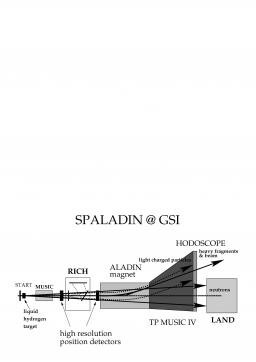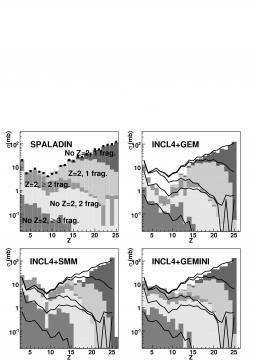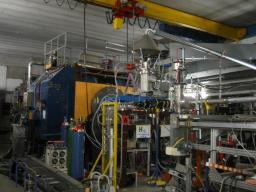
Fig. 1: Schematic view of the SPALADIN set-up from the top. The distance between the START detector and the LAND detector is approximately 10 m.
Presentation of the project
Physics & programmes
Spallation reaction study, physics data for nuclear energy
Goals of the experiment
Introduction
The experiment SPALADIN was designed and performed to study in detail the spallation of 56Fe at 1 GeV kinetic energy, iron being the main structural components of ADS, in particular for the vacuum window in between the spallation target and the proton accelerator.
The description of spallation is based on a two-step model: An intranuclear cascade (INC) leading to the formation of a highly excited nucleus, the prefragment, followed by its decay. The INC corresponds to the first instants of the spallation reaction, when, in the centre-of-mass frame, the incoming proton collides with nucleons of the target nucleus which may, subsequently, scatter on other nucleons of this nucleus. This leads rapidly to the formation of an excited system, the prefragment. In the two-step model, the assumption is made that the prefragment is in statistical equilibrium. The de-excitation of the prefragment is described by statistical models which may include different decay channels such as light-particle and fragment evaporation, binary decay, fission or multifragmentation. In the present study, we compare our data with one INC model, INCL4 and with three deexcitation models, GEM, GEMINI and SMM. GEM basically generalises the Weisskopf-Ewing evaporation to the production of intermediate-mass fragments (IMF), up to 24Mg. GEMINI computes the production of H, He, Li and Be within the Hauser-Feshbach formalism which takes into account the influence of the total angular momentum of the prefragment and the production of heavier IMF with asymmetric fission as computed within the transition-state model of L.G. Moretto. SMM includes in the decay channels the Weisskopf-Ewing evaporation of light IMF and the probability of multifragmentation (instantaneous break-up of the excited nucleus). We have not used the ABLA code for this study since, in its present version, this model does not take into account the direct production of IMF which was found a rather important part of the inclusive cross-section by C. Villagrasa-Canton et al. at the FRagment Separator (FRS) of GSI.
There are two techniques for the experimental study of spallation: Either the use of direct kinematics, where the proton beam is sent onto an atomic target, or the use of inverse kinematics, in which case the heavy-ion beam is directed onto a proton target. In the SPALADIN experiment we use the latter, the proton target being a liquid hydrogen target, approximately 88 mg/cm2.
Two advantages can be found to the use of inverse kinematics in the study of spallation. The first one is that the low centre-of-mass energy fragments produced in the reaction are focused in the forward direction, almost at 0 deg with respect to the beam direction. This means that a limited detection aperture in the forward direction provides, in the centre-of-mass frame, a high geometrical efficiency. The second advantage is that these fragments are also emitted with mainly the beam velocity ( v = 0.87 c at 1 GeV per nucleon), i.e. at high energy in the laboratory frame. Such a property allows an almost detection-threshold free measurement of IMF and spallation residues. The combination of these two features of the inverse kinematics provides a very efficient characterisation of the spallation final-state distribution when the different types of fragments and particles are measured in coincidence: Spallation (or heavy) residues, IMF, light-charged particles and neutrons. In principle, on an event-by-event basis, all the decay products of the prefragment should be detected in coincidence since such a set-up provides an almost full coverage of the prefragment-decay phase-space. The present work follows an effort of complete and extensive measurements performed at the Fragment Separator (FRS) of GSI (Darmstadt, Germany) on the detection and identification of heavy residues and fission products in the spallation of different nuclei, from 56Fe to 238U for energies ranging from 0.3 to 1.5 GeV per nucleon. With respect to these measurements, a more complete characterisation of the final states of spallation should permit a better understanding of the spallation mechanism, especially of the prefragment decay. In particular, the mechanism responsible for the production of intermediate-mass fragments could not be firmly identified with these inclusive measurements. The only conclusion which could be drawn is that the standard evaporation models, even extended to IMF, we not able to reproduce the data. Let us remark here that the analysis of the centre-of-mass velocity distributions of the IMF could be interpreted within SMM by the onset of multifragmentation. The SPALADIN experimental set-up, presented on fig. 1, was installed at GSI. It was mainly composed of a liquid-hydrogen target, a large aperture dipole (ALADiN), a tracking and charge-identification set-up dedicated to spallation residues in between the target and the magnet entrance flange, a time projection chamber (TPC) linked to a hodoscope for the detection of charged particles and a high-efficiency neutron detector (LAND). It is fully described in ref. the doctorate thesis of E. Le Gentil, published in 2006. The detection efficiencies of the different types of fragments and particles have been determined from the data analysis. They were found to be of 44 % for H, 78 % for He, 83 % for Li and above 94 % for the heavier fragments. The geometrical efficiencies of the set-up has been computed with a complete GEANT 4 simulation. They were found to be of the order of 20 % for the protons, 80 % for He and almost 100 % for the heavier fragments. The theoretical models have been filtered by this GEANT 4 simulation to perform the comparison with our data. Furthermore, because of the values estimated for the geometrical and detection efficiencies, we restrict the discussion below to the detection of fragments of charge Z ≥ 2. We find indeed that for the protons, we have an overall efficiency of 9 %, a rather small value.
We have identified five types of final states for the reaction 56Fe + p, depending on the number of detected fragments of charge Z ≥ 3: one fragment without any He (Z=2), one fragment with at least one He, at least two fragments with at least one He, two fragments without any He, at least three fragments without any He.
The contributions of these final states to the elemental production cross-sections are shown in fig. 2. Two basic features of these contributions can be seen in the data: 1) The production of heavy residues (Z ≥ 15) comes mainly, i.e. at least 90 % of the cross-sections, from the evaporation of neutrons, hydrogen isotopes or heliums; 2) IMF (3 ≤ Z ≤ 8) are produced essentially in reactions leading to at least two fragments in the final state. Moreover, it has to be underlined that the production of IMF in the reaction 56Fe + p at 1 GeV is in fact dominated by two-fragment final states. This means that asymmetric splitting, whether it is asymmetric fission as proposed by the transition-state model or fragmentation leading to two-fragment final states or any other mechanism, is dominating the production of IMF in this reaction. In particular, it seems that “classical” evaporation plays a smaller role for this part of the cross-section than for the production of heavy residues and that direct IMF production mechanisms are at play. The region of charges 9 ≤ Z ≤14 corresponds to a more equilibrated mixing of nucleon and helium evaporation with IMF production.
We have compared our data with GEM, GEMINI and SMM coupled to INCL4, as mentioned in the introduction. The comparison is displayed in fig. 2, top-right, bottom-left & right where the full curves give the SPALADIN data and the different final-state contributions from the models to the elemental cross-sections are depicted as histograms. This comparison shows that the basic features of the elemental cross-sections is rather well described by the models, except for GEM which underestimates strongly the production of fragments of charge 5 ≤ Z ≤ 12 by almost an order of magnitude. The decomposition of the elemental cross-sections into the different identified final states show its full interest. Indeed, the models’ predictions can vary by large factors for a given decay channel even when the agreement with the data on the elemental cross-sections can be rather satisfactory. The comparison with the data exhibits an agreement of INCL4+GEM for the nucleon- and helium- evaporation dominated channels (higher Z in fig. 2) and for the contribution of 3-fragment final states. INCL4+SMM overestimates significantly the multi-fragment channels, especially at the lower Z. Even if it does not describe the data perfectly, we can Z1-Z2 state, from this comparison, that INCL4+GEMINI provides a better description than the other two models.

Fig. 2: Identified contributions to the elemental cross-sections in the reaction 56Fe+p at 1 GeV per nucleon. The SPALADIN preliminary data are given in the top-left plot. "frag" means an ion of charge at least 3 in this plot. Top-right: The data (the full curves for the different contributions) are compared to the intranuclear cascade model INCL4 coupled to the de-excitation model GEM. Bottom-left: comparison of the SPALADIN data with INCL4 coupled to SMM. Bottom-right: The data are compared to the combination INCL4+GEMINI. Note that for these comparisons, the models have been filtered with the GEANT 4 simulation of the SPALADIN set-up.

Fig. 3: Correlations between the prefragment excitation energy E* and the variables Zbound (left) and M(n)+M(Z=2) (right) as computed with the GEANT 4 simulation of the SPALADIN set-up. See text for the definition of these variables.
The multi-fragment final states correspond to relatively high average prefragment excitation energies whereas the nucleon- and helium- evaporation channels are linked to relatively lower average excitation energies. In order to have a deeper look into the evolution of the decay mechanism from light-particle evaporation to direct emission of IMF, it appears necessary to study the evolution of this mechanism with the prefragment excitation energy. The first step of such a study is to find experimental observables correlated to this excitation energy. Following the NESSI collaboration and the ALADiN group, we attempted to use two variables: Zbound, the sum of the charges of the detected fragments except the hydrogen isotopes, and M(n) + M(He, Z = 2), the sum of the detected multiplicities of neutrons and helium isotopes. Using the GEANT 4 simulation of the SPALADIN experimental set-up, we could show that both variables are correlated to the prefragment excitation energy, as shown in fig. 3. Furthermore, we found that these correlations are independent of the de-excitation models we used: ABLA, GEM, SMM and GEMINI. This means that we can select detected events in prefragment excitation-energy bins using these observables and independently of any models.
Focusing the study on events with at least two fragments (Z ≥ 3), we select three ranges in the variable M(n) + M(He) to look at the evolution of the cross-section distribution of the charge difference Z1 − Z2 where Z1 and Z2 are the charges of the heaviest and of the second heaviest fragments of the event respectively, as shown on fig. 4. We observe in the data a trend from final states where the two fragments are rather different (Z1 − Z2 ranging from low values up to 14-16) to final states where the two heaviest fragments are of similar size (Z1 − Z2) remaining at low values, from 0 to 6). This signs a clear transition from rather asymmetric splittings to more symmetric ones. Such a transition is very well described by the GEMINI model and rather poorly by the other two. GEM predicts an almost constant Z1 − Z2 distribution with M(n) + M (He) whereas SMM predicts the presence of a bump in Z1 − Z2 for the first two ranges in M(n) + M(He) which is absent in the data. The distribution of Z1 − Z2 for the highest range of M (n) + M(He) is much better described by SMM.
In the SPALADIN experiment, we apply the inverse kinematics technique to the measurement of the reaction 1 GeV of proton kinetic energy in the centre-of-mass frame. Taking advantage of the properties of this technique, we can detect efficiently the low centre-of-mass kinetic energy fragments produced in the reaction, i.e. mainly the decay products of the prefragment formed at the end of the cascade phase of the reaction. This enables us to measure absolute cross-sections of multi-fragment final states. This gives us access to the absolute values of the partial decay widths of the prefragment. As shown here, such a measurement is a strong test-bench for spallation-mechanism models. We can show in particular that the production of intermediate mass fragments (IMF) in the reaction 56Fe + p at 1 GeV is mainly due to asymmetric splittings which give essentially two-fragment final states, a heavy and a lighter one, in coincidence with (most probably) evaporated light particles such as neutrons, H and He isotopes. Furthermore, this efficient coverage of the final-state phase space allows us to find experimental observables correlated to the excitation energy of the prefragment. We could show that these correlations are independent of the models used to describe the decay of the prefragment. This means that we are now able to study the evolution of the reaction mechanism with the prefragment excitation energy and analyse our data without the need to use any prefragment-decay model to estimate this excitation energy in the reaction.We have applied this feature to the study of the IMF production mechanism and shown that the evolution of the IMF production with the excitation energy of the prefragment is well described by the model GEMINI.
We are going to use to the same experimental technique, i.e. inverse kinematics and coincidence measurements, for two other studies of spallation : the study of the reactions 28S i + p and 136Xe + p, the measurement of the fission channels of the spallation of heavy nuclei.
Both experiments will be performed at beam energies ranging from 0.5 to 1 GeV per nucleon. The first measurement will complete the study presented here and will provide a mass dependence of the spallation mechanism and of the different reaction channels. The second experiment is aiming at measuring in coincidence the fission fragments, the evaporated neutrons and the produced heliums. Such a coincidence detection will allow to reconstruct the characteristics of the fissioning system, which is of major importance for the understanding and modelling of fission which occurs in spallation on highly excited systems (the prefragment produced at the end of the intranuclear cascade).
On a longer term, the SPALADIN collaboration is involved in the R3B collaboration. This collaboration has in charge the high-energy branch of the secondary-beam facility of the future FAIR project of GSI. R3B is building a new large-acceptance superconducting dipole magnet which will increase dramatically the final-state phase-space coverage of ion reactions in the GeV per nucleon range and, in particular, of spallation reactions in inverse kinematics. Using this new magnet and a larger time-projection chamber adapted to its dimensions, we will be able to measure in coincidence the light fragments, the neutrons, the fission products or the heavy residues of the spallation of nuclei such as 208Pb or 238U with a very high geometrical efficiency for all the reaction products. As we could compute using a GEANT 4 simulation of the future R3B set-up, the geometrical efficiency of the set-up should increase from 80 to 95 % for heliums and from 20 to 80 % for protons produced in spallation reactions. Such an experiment will be a definitive benchmark for theoretical models of spallation, for the intranuclear cascade phase as well as for the de-excitation phase. Because of the much improved coverage of the final-state phase space with respect to SPALADIN, we will be able to identify efficiently many different final states of the reaction, each of them, as shown here for the lighter system 56Fe + p, being a test for the spallation mechanism models. Furthermore, a more efficient detection of the decay products of the prefragment with respect to the present SPALADIN set-up, will allow to reconstruct experimental observables strongly correlated to the characteristics of the prefragment: Excitation energy, mass and charge. These observables will be good tests of the intranuclear cascade models and independent of the decay channels of the prefragment. In this respect, the two-step model of spallation will be fully tested within the same data: The INC models will be tested independently of the prefragment decay models and the decay models will be compared to the data in a way independent of the INC models, as is shown here with the SPALADIN data on the IMF production.
Contributions of the Dapnia
For the SPALADIN experiment, the DAPNIA has provided GSI with a liquid hydrogen target built by SACM as well as high-resolution position detectors installed in-between the target and the ALADiN magnet entrance in order to track the heavy residues of the spallation reactions occuring inside the target.
Responsabilities
The DAPNIA is in charge of the collaboration as the spokesperson is from SPhN
Size of the experiment
The collaboration started its work in 2000 with the feasibility study of the experiment and the submission of the proposal to the GSI program advisory committe where it was approved and given beam time.
The collaboration gathers around 30 physicists from 7 different European research institutes or universities.
Divisions of the DAPNIA involved in the experiment
SACM: in charge of the construction of the liquid hydrogen target.
SEDI: in charge of the construction of the high-resolution position detectors for the spallation residues produced in the target.
SPhN: in charge of the experiment as spokesperson.
Collaboration
- DAPNIA, CEA-Saclay, France
- GSI, Darmstadt, Germany
- Institut de Physique Nucéaire d'Orsay, CNRS/IN2P3, France
- Physics Department, University of Santiago de Compostella, Spain
- Physics Department, University of technology of Munich, Garching, Germany
- Jagellonian University, Krakow, Poland,
- Institut of Nuclear Physics, Krakow, Poland,
- GANIL, CEA/DSM & CNRS/IN2P3, Caen, France
Contacts
Instrumentation
Instruments
A new liquid hydrogen target with very thin windows (of a few micrometers of thickness) has been developed and built at the DAPNIA / SACM. High-resolution position detectors were built by DAPNIA / SEDI to ensure the tracking of the spallation residues in front of the dipole magnet ALADiN. Such a tracking was required to permit the reconstruction of the mass of the residues, in combination with a Ring Imaging Cherenkov provided by our collaborators from Garching.
LIFE OF THE EXPERIMENT
Historique et principaux jalons:
- The proposal was submitted to the program advisory committee of GSI in December 2000. It was accepted then and was attributed 8 days of beam time.
- The data taking of the experiment took place in February 2004, with success. Two measurements were performed with the 56Fe beam: at 1 GeV and at 0.5 GeV per nucleon.
- The data analysis of the 1 GeV data went on until Spring 2006 until the first results, shown here. The 0,5 GeV data analysis is still going on.
- The two proposals (the study of spallation of 28Si and of 136Xe and the study of the fission channels in the spallation of 181Ta, 208Pb and 238U) were presented to the GSI program advisory committe in Spring 2005 and attributed 8 days of beam time for each of them.
INTELLECTUAL PRODUCTION
- Publications:
- Conferences & workshops:
The data at 1 GeV per nucleon of the SPALADIN experiment were presented in the following conferences: "Nuclear Data 2004", Santa-Fe (USA), "Accelerator Applications 2005", Venezia (Italy), International Workshop on Multifragmentation 2005, Catania (Italy), "Nucleus-Nucleus Collisions 2006", Rio de Janeiro (Brazil), "Nuclear Data 2007", Nice (France), "Accelerator Applications 2007", Pocatello (USA)
- Theses:
E. Le Gentil, Doctorate thesis, University of Evry, September 2006, "Analysis of the spallation residues and of the associated particles in the reaction 56Fe+p at 1 GeV per nucleon"



